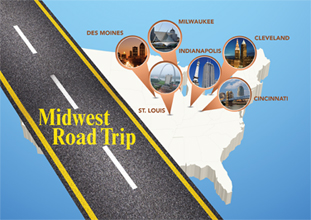While North America’s east, west, and southern coasts are defined by diversity and emerging ethnic populations, it’s easy to forget that the Midwest was once the American melting pot with Europeans settling in what was, in the early 1800s, the Western frontier.
Many of the farms and businesses still in operation today were established by families from mainly Germany, Poland, Italy, the Netherlands, Scandinavia, Ireland, and Scotland. Sam Maglio Jr. of Maglio & Company in Milwaukee, WI says, “The Midwest is rich in the heritage of family farms established in the 1800s. There’s a resurgence of second and third generation growers following in their ancestors’ footsteps, but using modern farming techniques and expanded food safety practices.”
Greg Corsaro, president of Indianapolis Fruit Company, headquartered in Indianapolis, IN, says he enjoys doing business in the Midwest. “Midwestern people are genuine and real. There is much diversity in the demographics and ethnicity of the area, and an abundance of different products grown.”
The states of Indiana, Iowa, Missouri, Ohio, and Wisconsin are home to slightly over 33 million inhabitants—10 percent of the U.S. population (see chart for current population and other facts). This region of the Midwest is on a path of slow but steady growth with many companies expanding their distribution area to the Northeast, the Chicago and Detroit metro areas, and south to Atlanta.
Central Advantage
Top Crops
During the late May through late October growing season, the Midwest is the source of many of the region’s highest volume fruits and vegetables. Key fruits include apples, peaches, berries, and melons. For vegetables, potatoes are a mainstay for several states, and the region is an important producer of tomatoes, cabbage, romaine, onions, and sweet corn. In addition, Wisconsin is the top producer of snap beans in the country.
Both Indiana and Ohio grow a substantial supply of tomatoes, with the Hoosier state also bringing in watermelon, blue-berries, and cucumbers. Ohio cropland is ideal for the aforementioned tomatoes and sweet corn, as well as green peppers, cucumbers, and squash. Although Wiscon-sin is known for its hardy vegetables, it is a powerhouse producer for cranberries, bringing in nearly 60 percent of the entire U.S. cranberry crop for 2012, valued at more than $230 million.
Missouri’s contributions include potatoes, watermelon, apples, peaches, grapes, and pecans, while Iowa, known for its bumper crops of feed corn and soybeans, produces a variety of apples, most of which is sold and consumed within the state, according to the Iowa Department of Agriculture and Land Stewardship.



